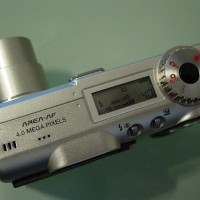After much deliberation, I finally got the Minolta F100 4-megapixel digital camera. As most of you know, my Sony DSC-S85, while taking amazing quality pictures, has started to bother me primarily because of its massive size which makes it not very travel-friendly (not to mention the peripherals that I had to additionally carry like the charger, USB cable, etc.). Compared to other digital cameras, the S85 just wasn’t cutting it. Hence, I wanted a new, smaller camera.
My constraints/desires were relatively simple 1) It had to be small and travel easily, and 2) I did not want to sacrifice the quality — it had to be a high-resolution camera. While this may sound simple, a number of further limitations immediately pops up. Let’s break it down a little. In order to achieve the desired travel size, one of the things I really wanted to get rid of was the charger. The S85 comes with this huge electrical converter. I had already bought a travel size quick charger, but it still had a cable I had to bring along thus adding to the weight. But what made matters worse was that I had to pay another US$40+ for the extra battery and another US$30+ for the charger.
So I looked around at my options were. How do I get a super small charger and not pay for extra batteries? The answer: rechargeable NiMH batteries. Yup, AA rechargeable batteries. I already had a travel Sony rechargeable batteries charger plus GP 1800 mAh batteries were less than US$8 for 4. That made the decision to find a camera that uses rechargeable AA batteries easier.
Next, I thought about memory. As I’ve written before, I’m not terribly happy that Sony is stuck at 128MB on the memory stick. Meanwhile, the Compact Flash format is flying with 512MB the norm now. With 4 Megapixel pictures, 128MB can go quickly. I wanted a memory format that was relatively flexible and that I knew would have higher memory cards. That really left me with two strong options, CF or SD. As I already had a few SD cards, I decided that it was probably the way to go. Plus, the 256MB SD card was available and the 512MB was on the way.
With these two factors alone, I narrowed my choices to a few models: the Olympus C-40Z, the Pentax Optio 330, and the Minolta Dimage F100. Other models that took AA batteries were generally too low in resolution. At the end, I settled for the F100 because it had both AA batteries and the SD card. Plus, I was reading some positive reviews/comments about the camera. My very first digital camera was a Minolta and it lasted quite a long time so I had some positive past impressions. I was leaning towards the Olympus because they are also supposed to be quite good, but I didn’t want to start down another memory format in the Smartmedia cards.
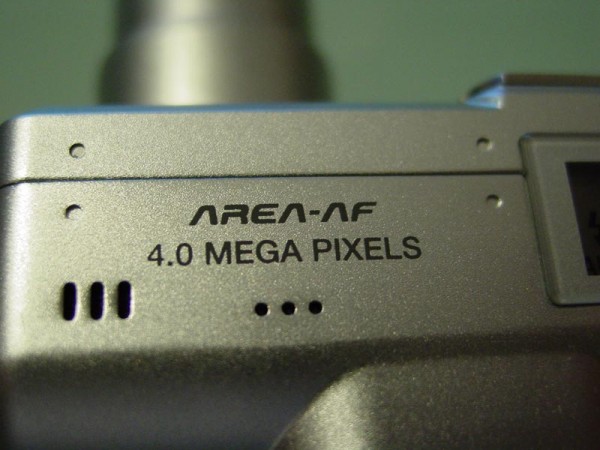
Minolta Dimage F100 Digital Camera 4MP
Form
As one of the smaller form digital cameras, the F100 is an extremely well built package. Some might say that the camera is too flat, resembling too much of a box, but I think that it’s extremely functional. Sure, some of the other digital cameras are shaped better (like certain models from Nikon, Fuji, and Canon), but have you ever tried to put one down on a table? Yup, they fall over. I’m not going to get into that issue. The bottom line is that this camera is a very well balanced camera. It is possible to operate the camera with just one hand and its light enough to take pictures with just the one hand too. I should add though that this has often led me to take blurred pictures because it’s not easy to hold a camera still with just one hand. It’s all too easy to forget this when you have such a small camera with you.
The LCD screen is extremely bright and is a very good size to see images. But, there is one thing I should add: some images on this small screen may appear clear when viewed, but when you blow them up on your computer screen, they can appear blurry. That’s because the screen is so small so it can be hard to make out some details. Still it’s a very functional and good screen.
The buttons are all very well placed and the doors to the battery and the SD card are well protected but easy to access (I’ve had problems with previous digital cameras). However, there is one big downside to the design, which I have seen mentioned a few times — the dial on the F100 which turns the camera on/off and moves between the different modes, turns much too easily. It’s pretty easy to “accidentally” turn the camera on while it’s in a bag, pocket, etc. This is a pretty inconvenient problem because as soon as you turn it on, the lens begins to extend from the body. Not to mention that leaving it on drains battery (even though it does turn off automatically). A minor design flaw but one to watch out for.
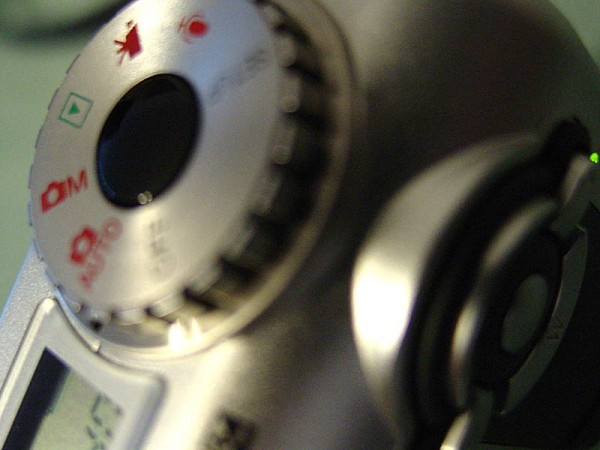
Minolta Dimage F100 Digital Camera dial
Function
The F100 is a typical digital camera. I’m not going to go into the major details of each nuance of the camera (there are way too many sites that do that anyways), but here are some finer details.
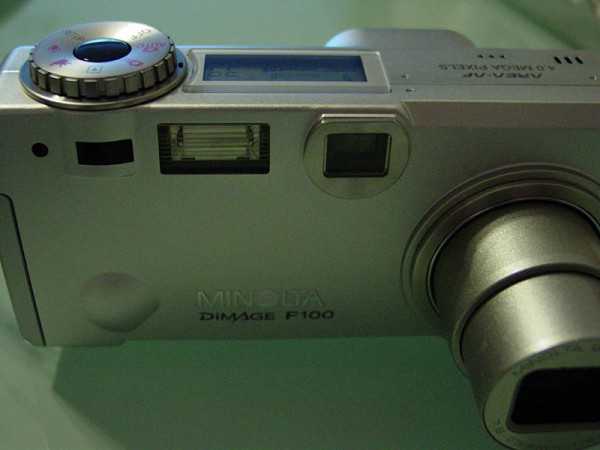
Minolta Dimage F100 Digital Camera front
First, let’s start with what it’s supposed to do – take pictures. Well, in this regard, I was relatively disappointed. If I had migrated from a 2MP or a 3MP digital camera, I would probably have been really positive and upbeat. But migrating from a 4MP camera like the S85 that had a huge, bright lens, the F100 images were a bit disappointing. I know it’s silly to compare, but the brightness, sharpness, and color of the Sony was better.
Don’t get me wrong though, the F100 takes good pictures. This 4MP is much better than other 3MP cameras I’ve used/had before. But it’s just not as good as cameras with a bigger lens though I guess that should be expected and is pretty understandable. I think most normal users will find it more than adequate especially if they are a bit lazy like me when it comes to digital photography. I just like a digital camera that you can turn on and snap away. The F100 does that very well. For those of you that like a bit more control, the camera does offer a bunch of manual modes, which are more than adequate for my camera needs.
One thing that Minolta is well-renowned for is the active area autofocus. There’s all this hype about it being able to track moving images, etc. While it might work well, it’s pretty much hidden in the background when it’s working and when you take pictures, you can see the autofocus point jumping around. Again, none of this makes a difference if you end up shaking the camera while you take a picture.
One thing that I found especially unusual is the power of the flash. It’s actually really strong. So much so that it’s easy to take pictures in very dark environments. You expect these small compact cameras to have weak flashes but not so with the F100. The big problem though is that it can overpower the picture either by making everything too bright or by overpowering the background. You have to experiment with different settings. The night mode, so you can take night pictures with the background still needs a bit of manual help. Having said that though, it’s nice to have a camera that can take pictures in dark places like a bar/club!
I had no other problems or issues. I like the MPEG function and the ability to record voice too. Although the start-up time is a bit slow, it’s probably in line with most other digital cameras. It is reasonably quick in terms of the time lag between photos. That though will be highly determined by your battery life, which brings me to my next point – battery life.
Battery life for the most part is really good. If you put in fresh, newly recharged batteries, you’ll fly through at least 40-50 pictures with flash without any problem. However, the thing about NiMH rechargeable AA batteries is that it does quickly lose power over time. I read somewhere that they lose about 15-20% of their power by just sitting around for a week.
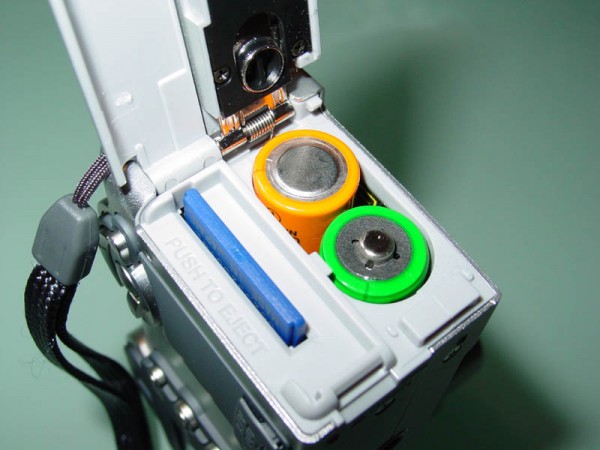
Minolta Dimage F100 Digital Camera battery
The Li-ion batteries that come with other cameras (like my Sony) will almost always do better. So be sure your AA rechargeables are fully charged before you head out or you might run out of battery. I’ve grown pretty accustomed to just slipping in newly charged batteries everytime I use the camera even if the batteries in the camera have some juice left. (I do not care as much about the memory effect as it’s supposed to be relatively minimized with NiMH as well as the fact that AA rechargeable batteries are cheap). It’s not a bad trade-off though given that you can also put in a Lithium CR-V3 battery that can be bought at photo shops if needed.
Factor
At the end of the day, the Minolta Dimage was everything I wanted in a small compact digital camera. Everything functions the way it is supposed to and I highly recommend it to anyone that wants a good point and shoot camera. Given its size, functions, resolution, and other things like the use of AA batteries, this camera is a clear winner.
So why then am I not happy with it? Well, it’s actually really simple. I’m a weird techno-geek. I can afford to have more than one digital camera so I don’t know why I tried to come up with one that was both small, yet powerful. See, I think you can’t really have both – well not to the level I want. As I wrote in an earlier blog, on the one hand, I want a camera that takes amazing photos, but on the other, I want something really small and easy to travel with. Don’t get me wrong, the F100 is super easy to travel with, but there are a whole bunch of new digital cameras out there that are smaller (albeit with lower resolution). Still, I draw a distinction between quality and fun.
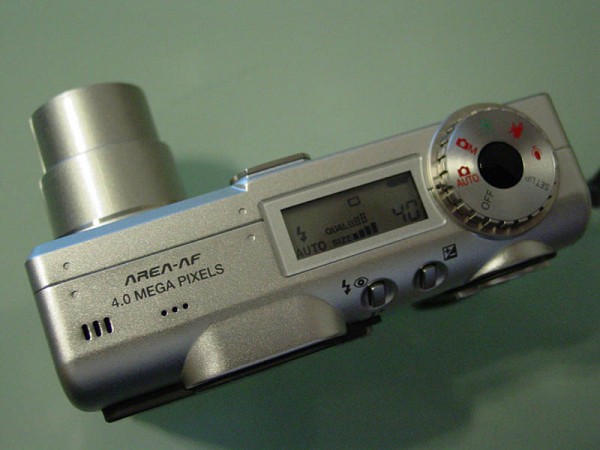
Minolta Dimage F100 Digital Camera top
So that’s what I’m going to do. As I’ve been writing, I’ve been eyeing digital cameras on the high-end (Nikon D100, Canon 1Ds, and Fuji S2 Pro) and also a few on the low-end (Sony U20 and Casio Exilim). I would definitely rate this camera an essential buy for anyone that wants an all in one digital camera. There aren’t too many people with my kind of needs so I’m sure this camera is well suited for many. All things considered, it’s really good. Having said that though, I’m rating this a MONEY TO BURN gadget because Minolta just came out with the F300 which is essentially the same camera but with a 5 mega-pixel camera. You can never have too much resolution!
